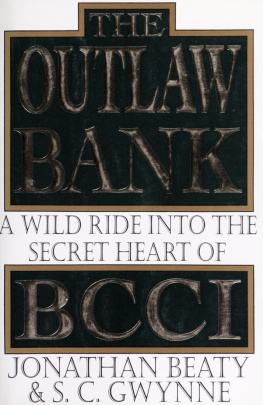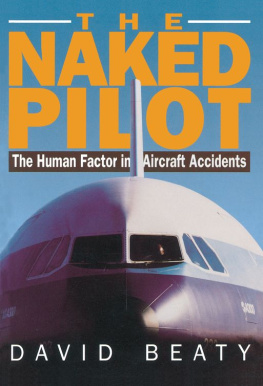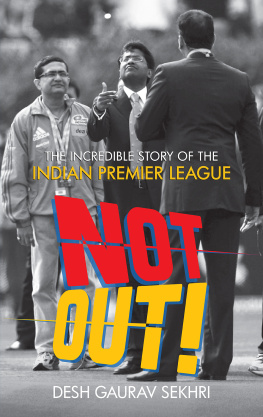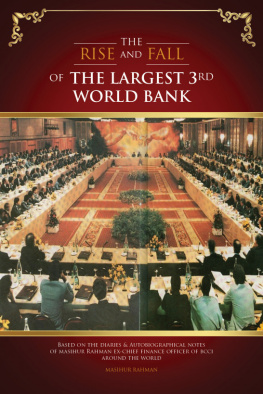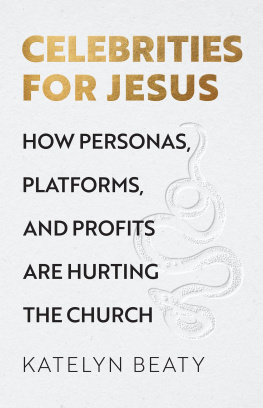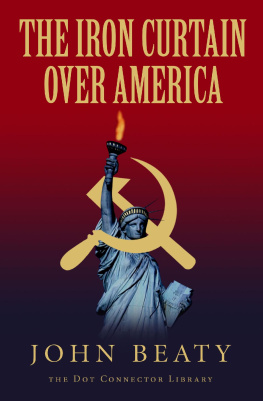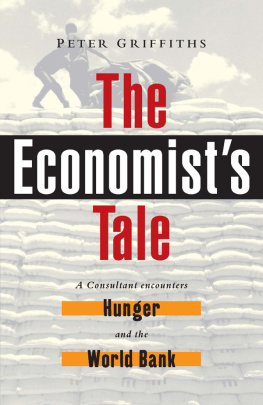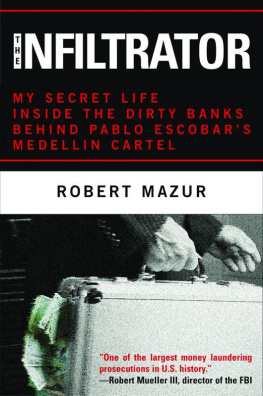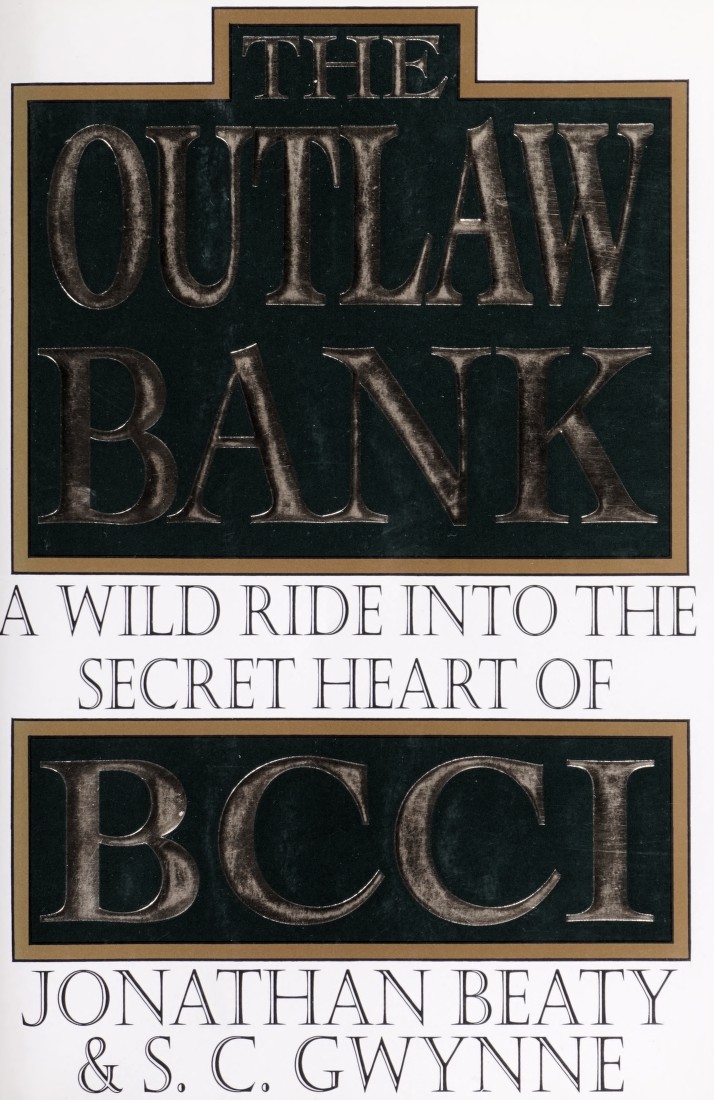
The outlaw bank
Also by S. C. Gwynne
SELLING MONEY
THE OUTLAW BANK
RANDOM HOUSE NEW YORK
FOR LINDA AND KATIE
ACKNOWLEDGMENTS
Although our names appear on the front of this book, there were many colleagues and friends who helped to make it possible.
The Outlaw Bank grew out of an eighteen-month-long series of articles in Time magazine, whose managing editor, Henry Muller, and chief of correspondents, John Stacks, let us run with the story and placed considerable resources at our disposal. Their support was unwavering, despite threats of multimillion-dollar lawsuits from figures connected to BCCI and despite strong assertions, especially in the early days of the story, from law enforcement authorities who claimed that we had it all wrong and that the government wasnt trying to bury the real facts. Throughout the project Time's deputy chief of correspondents, Joelle Attinger, provided constant guidance, sympathy, and much-needed reality checks. Her assistant, Ann King, did so many things for us, often under deadline pressure, that we scarcely know where to begin to thank her. Steve Koepp, Geoff Colvin, and Barry Seaman, who edited our Time articles, showed extraordinary patience with our chronic lateness and helped make an abstruse subject understandable to our readers. The work of others in Time's business sectionJohn Greenwald, Bernie Baumohl, Sue Washburn, and Jane Van Tasselwas similarly invaluable. Although our names were on the several journalism awards that Time eventually won for the BCCI stories, staff writer John Greenwald wrote a number of the articles based on our reporting and reports from other Time correspondents. We would also like to thank Bob Marshall and Nick Jollymore, Times legal counsel, for their excellent and attentive reviews that helped make our stories bulletproof: Despite the threats of law-suits, none actually materialized.
We were also the beneficiaries of the extraordinary talents of our book researcher, John Dickerson, who did everything from building our state-of-the-art computer data base to tracking down leads to baby-sitting some of our more intimidating sources. John was in every sense a full partner in this enterprise.
Some of the reporting reflected in this book came from others within Times News Service. Adam Zagorin, Times Brussels bureau chief, came through in the clutch several times with information and interviews we could not have gotten on our own. Correspondent Rich Behar, Houston bureau chief Dick Woodbury, and former New Delhi bureau chief Ned Desmond all contributed excellent and original material to our Time articles. Miami bureau chief Cathy Booth was an unsung contributor: In the best tradition of journalism, she declined a deserved byline on a story containing an important breakthrough about the governments cover-up efforts in order to protect her source. Rome-based Time photographer Rudi Frey ventured far beyond the call of duty to help us out, as chronicled herein. We owe a great deal to all of our colleagues at Time magazine, but perhaps our greatest debt is to John Stacks, whose determination to unravel the mystery of BCCI made it all possible.
Many sources on several continents helped make this story possible: Some of them risked their lives, and many of them risked their reputations and jobs. We cannot name many of the honest and dedicated people in law enforcement and government who provided information simply because they believed the truth was more important than political expediency, nor can we identify all of the former BCCI employees who came forward but still fear retaliation. The exception to that latter category is Masihur Rahman, the former chief financial officer of the bank, who first explained to us the financial legerdemain that resulted in the disappearance of billions of dollars. Rahman later, and bravely, made this information public in testimony before a Senate subcommittee.
But we can thank the following: Jack Blum, the former Senate special counsel, who more than anyone else is responsible for exposing the BCCI scandal; Senator John Kerry of Massachusetts and his aides Jonathan Winer and David McKean, whose tireless efforts to uncover the truth about BCCI provided us with much material; Joe Coyne, Virgil Mattingly, and the late William Taylor of the Federal Reserve, who were generous with their time; and James Dougherty, a Miami attorney who did much to advance the investigation of BCCI. We would also like to acknowledge the contribution of Shahid Javed Burki, the author of several scholarly works on Pakistan, who provided valuable insights about the country that gave birth to BCCI.
We appreciate the considerable efforts of our agent, Esther Newberg of ICM, in placing our manuscript and in staying close to it as it moved tortuously forward. The enthusiasm of Random House publisher Harry Evans launched this book, and our editors Ann Codoff and Ken Cellman at Random House were wonderful to work with and provided critical help in structuring it. Ms. Codoffs faith in the project never wavered and her constant support carried us past moments of doubt. The excellent eye of our copy editor, Patty Romanowski, also helped shore us up.
And lastly, wed like to thank John and Jodell Downs in Truth or Consequences, New Mexico, who made our time there writing this book both exciting and memorable. Every day, for the best part of a year, Mr. Downs unfailingly poked his head into our office and asked why we werent typing. It kept us from missing our Time editors in New York.
CONTENTS
ACKNOWLEDGMENTS
CAST OF CHARACTERS
CHRONOLOGY
INTRODUCTION: the devils paymaster
Part One: The Chase
1 BACK CHANNELS
2 CURIOUSER AND CURIOUSER
3 INTO THE LOOKING GLASS
4 PIERCING THE SCAMs HEART
5 TO ABU DHABI AND BEYOND
6 END OF EMPIRE
Part Two: The Rise of the Outlaw Bank
7 OUT OF THE BLUE
8 GILT BY ASSOCIATION
9 THE BLACK RAJ
Part Three: Bankers, Guns, and Money
10 ROCK AND ROLL
11 THE BANK THAT CAN GET YOU ANYTHING
12 THE HIDDEN ALLIANCE
13 Mr. Caseys bank
Part Four: The Cover-Up
14 THE BIG SLEEP
15 BEYOND ZERO
EPILOGUE
NOTES
CAST OF CHARACTERS
Agha Hasan Abedi: Pakistani financier who founded BCCI in 1972 with the intention of forming the Third Worlds first multinational bank.
Kanial Adham: The former head of Saudi Arabian intelligence and brother-in-law of the late King Faisal; shareholder in BCCI and First American Bank.
Sani Ahmed: Head of BCCI's protocol department in Pakistan until moving to Washington, D.C., to run BCCI's representative office.
Asaf Ali: Pakistani multimillionaire and arms dealer.
Robert Altman: Former president of First American Bank and Clark Cliffords law partner/protege. Altman also served with Clifford as BCCI's chief American counsel from 1978 to 1990.
Amjad Awan: Former manager of BCCI Panama who handled Manuel Noriegas personal banking.
Munther Ismael Bilheisi: Expatriate Jordanian involved in coffee smuggling, arms dealing, customs violations, money laundering, and paying bribes and kickbacks.
Jack Blum: Former investigator and chief counsel to Senator John Kerrys Subcommittee on Terrorism, Narcotics, and International Operations.
Lord Callaghan: A former British prime minister, Callaghan was a paid economic adviser to BCCI.
Roy P. M. Carlson: Bank of America executive who orchestrated BofAs original investment in BCCI, and who, at Chaith Pharaons request, became head of National Bank of Georgia.
Jimmy Carter: Thirty-ninth president of the United States who accepted millions from Abedi and BCCI for charitable organizations.
Next page
